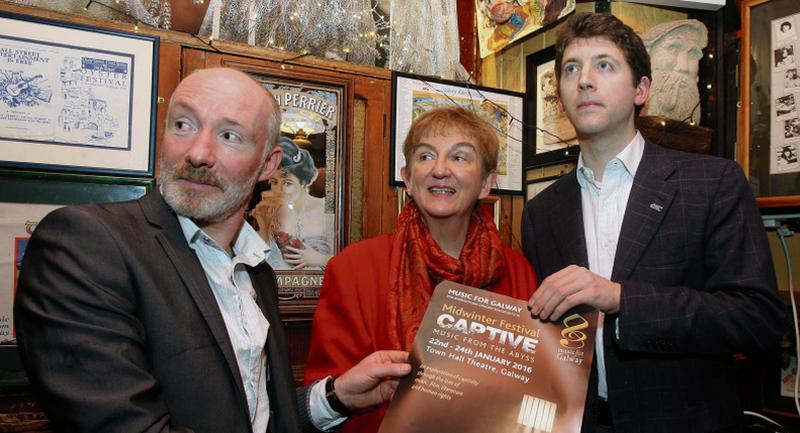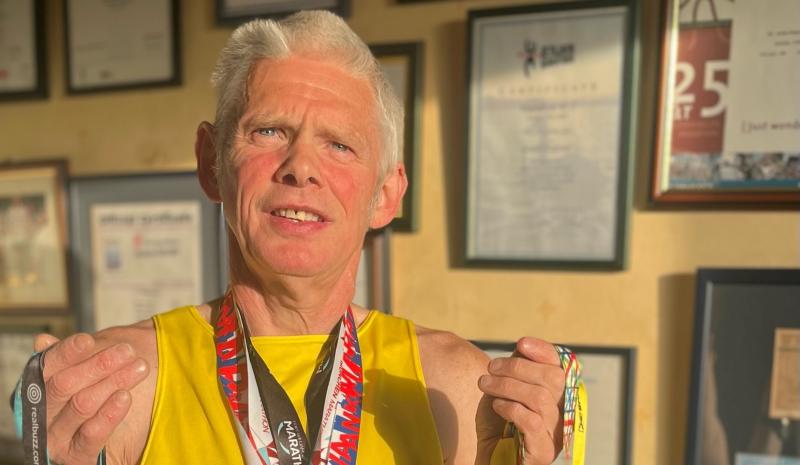Featured
How music brought joy in humanity’s darkest days

Lifestyle – Judy Murphy hears about a Galway festival that will put the focus on music from captivity
Watching the news these days isn’t exactly good for the soul, given the endless accounts of atrocities and inhuman behaviour coming from all parts of the world, especially the Middle East.
But even in the most horrendous of circumstances people are capable of great resilience and acts of kindness. And resilience and decency will be among the themes explored next weekend, January 22-24, when Music for Galway hosts its annual Midwinter Festival.
The theme of this year’s festival is Captive – Music from the Abyss and it mixes Oscar Wilde’s moving poem, The Ballad of Reading Gaol, with songs from a Nazi concentration camp, while throwing in an extra-terrestrial alien just for good measure. There’s also a talk from one of the world’s leading experts in human rights law, William Schabas, professor emeritus at NUIG, now at the University of Middlesex in England.
Captive – Music from the Abyss is the brainchild of Music for Galway’s Artistic Director, Finghin Collins. The idea was planted when he attended a concert in at Dublin’s Royal Hospital in Kilmainham in 2011, part of the Festival of Music in Great Irish Houses.
Irish Soprano Lynda Lee sang a series of songs from the Nazis’ ‘model ghetto’, Theresienstadt, at that event and “it moved me”, Finghin says simply. He explains that many of the songs would have been sung to children in the camp at this fortress town some 30 miles from Prague, where thousands met their death.
The Theresienstadt/Terezín ghetto, set up in 1941 by the Nazis was cited in their propaganda as ‘The Fuhrer’s gift to the Jews’. It was some gift. In 1942, half of its 32,000 population died from disease and malnourishment as it served as a holding station for camps such as Auschwitz-Birkenau, where the gas chambers killed millions.
But, despite massive overcrowding, appalling sanitation, and food shortages, it had its own orchestra, theatre group and soccer teams.
As much as possible, the adults in Theresienstadt – many of them from an artistic background – tried to make life bearable for the younger residents. Among those who shone in this regard was Ilse Weber, whose songs will feature in the Music for Galway festival. Ilse, her husband and young son were sent to the camp in 1942. There the poet and musician worked as a night nurse in the children’s infirmary and did everything in her power for the young patients in a place where medicine was forbidden. She wrote around 60 poems during her imprisonment and set many of them to music.
At the 2011 concert in Kilmainham, Lynda Lee performed some of the lullabies Ilse sang to the children of Theresienstadt, as well as songs written by other composers in the camp.
Lynda will also sing at Captive – Music from the Abyss, and she and Finghin have selected material specifically for her performance next Saturday night, when she will be accompanied by Finghin and members of the US-based chamber ensemble, Decoda. While much of the music at Theresienstadt was composed under duress for Nazi propaganda, it also offered comfort to prisoners and the recital will reflect that.
As Finghin built a festival around that music, he decided to broaden its remit and have it include literature, theatre and film. This marks a new departure for Music for Galway’s Midwinter Festival, which has been a fixture on Galway’s arts scene for several years.
Other elements in this year’s programme include the screening of a 39-minute Oscar-nominated film The Lady in No 6, about Alice Herz-Sommer, who was 110 when she died in 2014 – the oldest known survivor of the Holocaust. It will be screened on Saturday night alongside the programme of Music from Theresienstadt/Terezín.
The Lady in No 6 was made when Alice was 109 and it explored her extraordinary life. A talented concert pianist, from Prague, she was sent to Theresienstadt in 1943 with her husband and small son.
For more, read this week’s Connacht Tribune.
Connacht Tribune
West has lower cancer survival rates than rest

Significant state investment is required to address ‘shocking’ inequalities that leave cancer patients in the West at greater risk of succumbing to the disease.
A meeting of Regional Health Forum West heard that survival rates for breast, lung and colorectal cancers than the national average, and with the most deprived quintile of the population, the West’s residents faced poorer outcomes from a cancer diagnosis.
For breast cancer patients, the five-year survival rate was 80% in the West versus 85% nationally; for lung cancer patients it was 16.7% in the west against a 19.5% national survival rate; and in the West’s colorectal cancer patients, there was a 62.6% survival rate where the national average was 63.1%.
These startling statistics were provided in answer to a question from Ballinasloe-based Cllr Evelyn Parsons (Ind) who said it was yet another reminder that cancer treatment infrastructure in the West was in dire need of improvement.
“The situation is pretty stark. In the Western Regional Health Forum area, we have the highest incidence of deprivation and the highest health inequalities because of that – we have the highest incidences of cancer nationally because of that,” said Cllr Parsons, who is also a general practitioner.
In details provided by CEO of Saolta Health Care Group, which operates Galway’s hospitals, it was stated that a number of factors were impacting on patient outcomes.
Get the full story in this week’s Connacht Tribune, on sale in shops now, or you can download the digital edition from www.connachttribune.ie. You can also download our Connacht Tribune App from Apple’s App Store or get the Android Version from Google Play.
Connacht Tribune
Marathon Man plans to call a halt – but not before he hits 160 races

On the eve of completing his 150th marathon, an odyssey that has taken him across 53 countries, Loughrea’s Marathon Man has announced that he is planning to hang up his running shoes.
But not before Jarlath Fitzgerald completes another ten races, making it 160 marathons on the occasion of his 60th birthday.
“I want to draw the line in 2026. I turn 57 in October and when I reach 60 it’s the finishing line. The longer races are taking it out of me. I did 20 miles there two weeks ago and didn’t feel good. It’s getting harder,” he reveals.
“I’ve arthritis in both hips and there’s wear and tear in the knees.”
We speak as he is about to head out for a run before his shift in Supervalu Loughrea. Despite his physical complaints, he still clocks up 30 miles every second week and generally runs four days a week.
Jarlath receives injections to his left hip to keep the pain at bay while running on the road.
To give his joints a break, during the winter he runs cross country and often does a five-mile trek around Kylebrack Wood.
He is planning on running his 150th marathon in Cork on June 4, where a group of 20 made up of work colleagues, friends and running mates from Loughrea Athletics Club will join him.
Some are doing the 10k, others are doing the half marathon, but all will be there on the finishing line to cheer him on in the phenomenal achievement.
Get the full story in this week’s Connacht Tribune, on sale in shops now, or you can download the digital edition from www.connachttribune.ie. You can also download our Connacht Tribune App from Apple’s App Store or get the Android Version from Google Play.
CITY TRIBUNE
Galway ‘masterplan’ needed to tackle housing and transport crises

From the Galway City Tribune – An impassioned plea for a ‘masterplan’ that would guide Galway City into the future has been made in the Dáil. Galway West TD Catherine Connolly stated this week that there needed to be an all-inclusive approach with “vision and leadership” in order to build a sustainable city.
Deputy Connolly spoke at length at the crisis surrounding traffic and housing in Galway city and said that not all of the blame could be laid at the door of the local authority.
She said that her preference would be the provision of light rail as the main form of public transport, but that this would have to be driven by the government.
“I sat on the local council for 17 years and despaired at all of the solutions going down one road, metaphorically and literally. In 2005 we put Park & Ride into the development plan, but that has not been rolled out. A 2016 transport strategy was outdated at the time and still has not been updated.
“Due to the housing crisis in the city, a task force was set up in 2019. Not a single report or analysis has been published on the cause of the crisis,” added Deputy Connolly.
She then referred to a report from the Land Development Agency (LDA) that identified lands suitable for the provision of housing. But she said that two-thirds of these had significant problems and a large portion was in Merlin Park University Hospital which, she said, would never have housing built on it.
In response, Minister Simon Harris spoke of the continuing job investment in the city and also in higher education, which is his portfolio.
But turning his attention to traffic congestion, he accepted that there were “real issues” when it came to transport, mobility and accessibility around Galway.
“We share the view that we need a Park & Ride facility and I understand there are also Bus Connects plans.
“I also suggest that the City Council reflect on her comments. I am proud to be in a Government that is providing unparalleled levels of investment to local authorities and unparalleled opportunities for local authorities to draw down,” he said.
Then Minister Harris referred to the controversial Galway City Outer Ring Road which he said was “struck down by An Bord Pleanála”, despite a lot of energy having been put into that project.
However, Deputy Connolly picked up on this and pointed out that An Bord Pleanála did not say ‘No’ to the ring road.
“The High Court said ‘No’ to the ring road because An Bord Pleanála acknowledged it failed utterly to consider climate change and our climate change obligations.
“That tells us something about An Bord Pleanála and the management that submitted such a plan.”
In the end, Minister Harris agreed that there needed to be a masterplan for Galway City.
“I suggest it is for the local authority to come up with a vision and then work with the Government to try to fund and implement that.”












